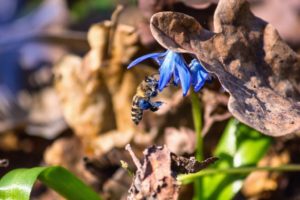
Native Oaks
Planting natives are one of the best ways to assist pollinators. Native oaks, like black oak, white oak, pin oak, or swamp chestnut oak, support pollinators throughout the year in many ways, but especially by providing winter shelter and healthy habitat. In fact, oaks give more than 500 pollinator species a home and enable them to return for years to come. The tree height depends on variety, but the black and white oak can easily grow to a height of 60’ with a spread of 60’ or larger at maturity.
Southern Magnolia
Bees love this tree’s vibrant white to cream-colored flowers that are filled with pollen. Then, later in the spring, birds enjoy the tree’s yummy fruit. All year round, you’ll get to admire the shiny, evergreen leaves of this Southern staple. This tree can grow to a height of 80’ with a spread of up to 40’.
Eastern Redbud
This tree’s blooms are some of the first to blossom in spring. Bees of all kinds, including honey, bumble, and mason bees, enjoy its pollen and nectar. The rest of the year, birds and insects appreciate what this tree must offer. Growing about 25’ tall with a 25’ spread, this tree, filled with heart-shaped leaves, will sure to be one of your prettiest trees.
Black Gum
A black gum tree provides colorful pops of foliage to the fall landscape. But its yellow, red and orange leaves appeal to the bee population in a completely different way. The flowers provide a source of food for bees during springtime and the bark offers a safe home. This tree can grow to 50’ tall and 30’ wide when mature.
Tulip Tree
The large, tulip-like flowers produced by the yellow poplar give this tree its name. While not actually a poplar, this tree is a member of the magnolia family. Its greenish-yellow blooms and sweet nectar attract pollinators. This tree needs a lot of space, so plan for them to keep growing. At maturity, it can be 90’ tall with a spread of 40’.
▪Reprinted excerpt from The Arbor Day Foundation


